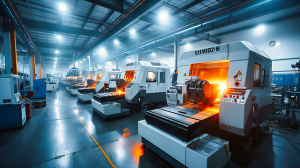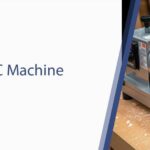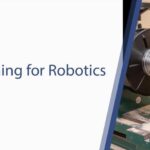How Can SMEs Adopt Artificial Intelligence and IoT for CNC Manufacturing?
Small and Medium-Sized Enterprises (SMEs) must turn to innovative technologies to achieve significant efficiency and competitive advantage with limited resources.
CNC machines are one of the cornerstones of industrial manufacturing, and in recent years, they have become smarter due to technological advancements.
Artificial Intelligence (AI) and the Internet of Things (IoT) have become important tools for enhancing the efficiency of CNC machines, reducing operational costs, and optimizing production processes.
The adoption of these technologies by SMEs can not only increase productivity but also provide a competitive edge. However, this process requires the integration of the right strategy and the right technologies.

Key Benefits of Artificial Intelligence and IoT Technologies
Real-Time Monitoring and Data Collection with IoT
IoT enables the continuous collection of data from machines. CNC machines typically operate with high precision, and even a small error can reduce production efficiency.
IoT enhances operational efficiency by providing a continuous flow of data that monitors critical parameters such as temperature, vibration, speed, pressure, and motor performance of these machines.
For example, vibration sensors can detect mechanical issues in machines at an early stage. Similarly, temperature sensors can provide early warnings when motors or electronic components overheat. These data help operators monitor machines and optimize their operational efficiency.
Optimization and Predictive Maintenance with Artificial Intelligence
Artificial Intelligence algorithms can create a more efficient working environment for machines by analyzing large datasets provided by IoT. AI not only observes current conditions but can also predict potential failures in machines, optimize production processes, and more accurately estimate the lifespan of cutting tools.
For instance, optimizing the cutting speed of a CNC machine can improve production quality and increase production speed. AI analyzes historical production data to determine the optimal speeds and parameters under specific conditions. Moreover, AI algorithms can predict maintenance requirements for machines, thus preventing unexpected breakdowns.
Steps for Integrating Artificial Intelligence and IoT in SMEs
The integration of Artificial Intelligence and IoT in SMEs requires a phased and carefully planned process. Below are the steps that SMEs should follow to integrate these technologies into CNC manufacturing.

Step 1: Building the Technological Infrastructure
To successfully integrate IoT and AI, the right infrastructure must first be established. This infrastructure begins with installing sensors necessary to collect data from machines.
SMEs can integrate sensors such as temperature, pressure, and vibration sensors into CNC machines. These sensors typically operate with wireless communication devices (Wi-Fi, Bluetooth, ZigBee).
Additionally, cloud-based solutions can be used to securely collect and process data. Cloud platforms facilitate data storage and access while enabling centralized control to accelerate data analysis. When building this infrastructure, SMEs should opt for flexible solutions while considering their existing systems.
Step 2: Establishing Data Collection and Analysis Processes
The data collection process involves the large data flow that IoT sensors will gather.
This data provides insights into the functioning of each machine. SMEs should use data management software to ensure that this data is collected accurately.
The data is continuously transferred to a central data pool and analyzed to generate meaningful information.
While analyzing this data, Artificial Intelligence uses machine learning algorithms to detect abnormal conditions and check whether the machines are operating healthily.
For example, an AI algorithm could help predict potential failures by analyzing vibrations occurring in a machine.
Step 3: Small-Scale Pilot Applications
It is recommended that SMEs start with small-scale pilot projects before rolling out the integration of AI and IoT across all their factories.
These pilot projects not only test the feasibility of the technology but also accelerate the learning process needed to implement it. These types of projects make initial costs more manageable while highlighting the potential benefits of the integrated systems.
Challenges and Solutions
The process of integrating Artificial Intelligence and IoT may involve several challenges for SMEs. To overcome these challenges, SMEs need to adopt a strategic approach.
Financial Constraints
One of the major challenges for SMEs is the initial cost of these technologies. IoT sensors, network infrastructures, cloud-based solutions, and AI software can incur high initial costs.
However, with cloud platforms, open-source software, and IoT devices becoming increasingly affordable, the accessibility of these technologies for SMEs is improving. Additionally, SMEs can observe the return on investment (ROI) by ensuring that the processes provide greater efficiency and cost savings.
Lack of Technical Knowledge
The implementation of Artificial Intelligence and IoT technologies requires technical knowledge. The existing engineering and operator teams in SMEs must be trained to use these new technologies. This training should cover how machines will become digitized and how data will be analyzed.
Additionally, external consultancy can be sought for assistance with more complex technological integrations.
Data Security and Privacy
The data collected by IoT devices can be transferred and stored on cloud platforms. However, data security and privacy can be a major concern for SMEs. To address this, SMEs must implement strong cybersecurity measures to ensure the secure processing and storage of this data.
Moreover, solutions that comply with data privacy laws such as GDPR should be preferred.
Conclusion: A Critical Step for the Future of SMEs
The integration of Artificial Intelligence and IoT presents significant opportunities for SMEs to enhance CNC manufacturing processes and gain a competitive edge.
These technologies provide powerful tools for faster production, lower costs, and better decision-making. By integrating IoT and AI with the right strategy, SMEs can make their production processes more flexible, efficient, and sustainable.
However, for successful integration, critical factors such as financial planning, technical expertise, training, and data security must be considered. The adoption of these technologies can be a key step in the industrial digital transformation journey of SMEs.
Contact Us:
- E-Mail: info@radonix.com
- Phone: +90 (553) 920 5500








